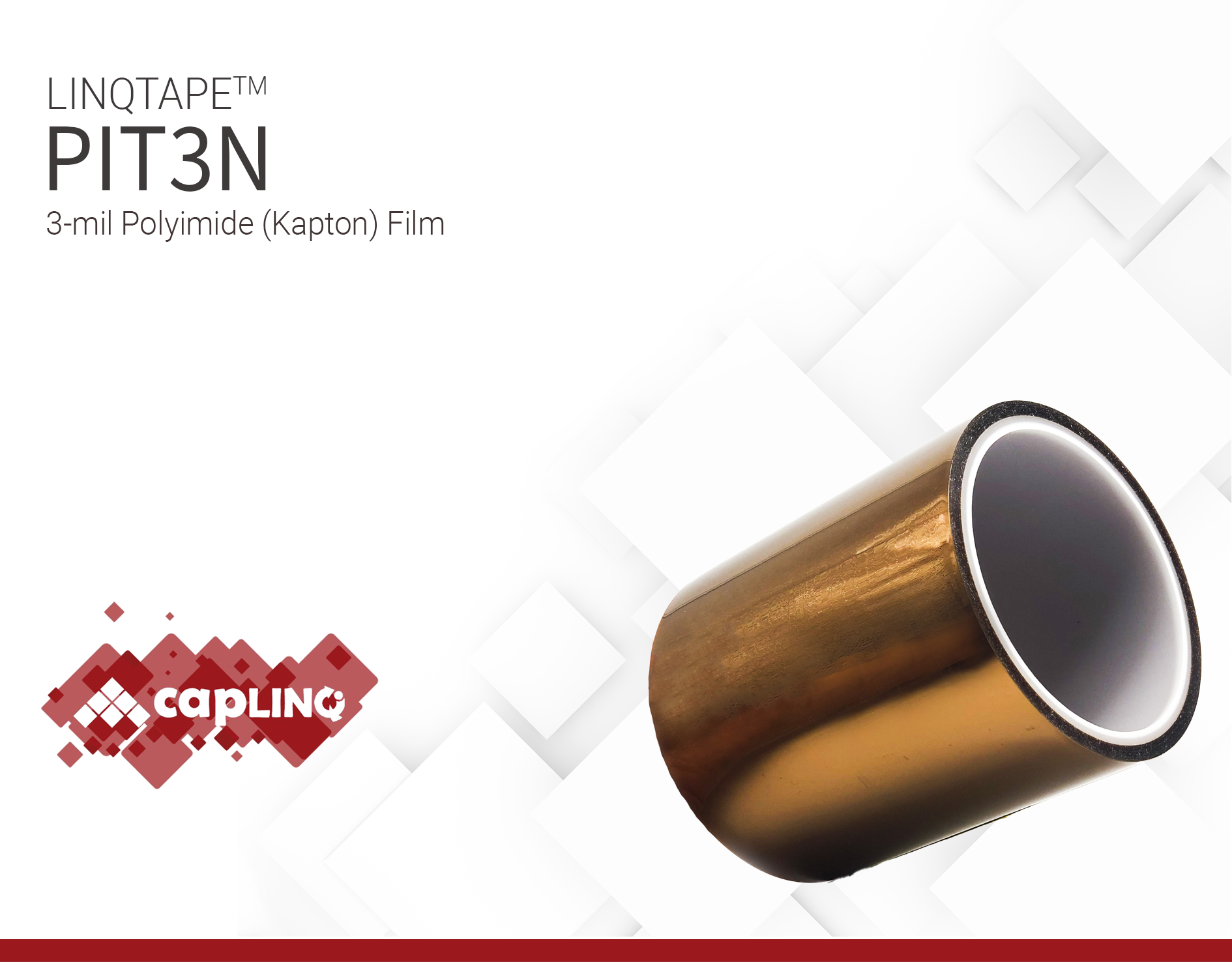PIT3N | 3-mil Polyimide (Kapton) Film
- 3 mil polyimide film
- No adhesive
- >13,500V breakdown voltage
Product Description
LINQTAPE™ PIT3N-Series is a high performance, flexible, hightemperature resistant polyimide film for many high temperature applications. Polyimide is preferred over polyester for many high temperature applications. These applications include but are not limited to semiconductor, smartcard, electronic, automotive and general manufacturing industries.
LINQTAPE™ PIT3N-Series provides an excellent balance of electrical, mechanical, thermal, and chemical properties over a wide range of temperatures. It can be used in applications that may see temperatures up to 400°C (752°F).
LINQTAPE™ PIT3N-Series comes in 33 meter (36 yard) length rolls of varying widths. The base polyimide film (backing) thickness is 2-mil (50.8 ± 2µm) thick. Polyimide films are available in a range of thicknesses, starting from 0.5 mil (12.7µm) thickness and up. Custom thicknesses are available upon request.
Technical Specifications
| General Properties | |||||
| Adhesive Layer Adhesive Layer A layer that is applied to one surface or both to bind items together and resist their separation | None | ||||
| Color Color The color | Amber | ||||
| Film Thickness Film Thickness Film thickness is the thickness of a backing film without taking into account any coatings or adhesive layers. It is measured in micron and the conversion factor to mil is 0.039. | 76.2 µm | ||||
| Special Layer | None | ||||
| Total Thickness Total Thickness Total thickness is taking into account all the films, coatings, adhesives, release liners and special layers and is the maximum thickness of a film or tape. | 76.2 μm | ||||
| Electrical Properties | |||||
| Breakdown Voltage Breakdown Voltage Breakdown voltage is the minimum voltage necessary to force an insulator to conduct some amount of electricity. It is the point at which a material ceases to be an insulator and becomes a resistor that conducts electricity at some proportion of the total current. After dielectric breakdown, the material may or may not behave as an insulator any more because of the molecular structure alteration. The current flow tend to create a localised puncture that totally alters the dielectric properties of the material. This electrical property is thickness dependent and is the maximum amount of voltage that a dielectric material can withstand before breaking down. The breakdown voltage is calculated by multiplying the dielectric strength of the material times the thickness of the film. | 13500 V | ||||
| Dielectric Strength Dielectric Strength Dielectric strength is measured in kV per mm and is calculated by the Breakdown voltage divided by the thickness of the tested material. Those two properties go hand in hand and while Breakdown voltage is always thickness dependent, dielectric strength is a general material property. As an example, the dielectric strength of Polyimide is 236 kV/mm. If we place 1mm of Polyimide between two electrodes, it will act as an insulator until the voltage between the electrodes reaches 236 kV. At this point it will start acting as a good conductor, causing sparks, potential punctures and current flow. | 200 kV/mm | ||||
| Volume Resistivity Volume Resistivity Volume resistivity, also called volume resistance, bulk resistance or bulk resistivity is a thickness dependent measurement of the resistivity of a material perpendicular to the plane of the surface. | 1.0x1013 Ohms⋅cm | ||||
| |||||
| Mechanical Properties | |||||
| Elongation Elongation Elongation is the process of lengthening something. It is a percentage that measures the initial, unstressed, length compared to the length of the material right before it breaks. It is commonly referred to as Ultimate Elongation or Tensile Elongation at break. | 50 % | ||||
| Thermal Properties | |||||
| Temperature Resistance Temperature Resistance Temperature resistance is the maximum temperature that the material or product can withstand for a period of time. The temperatures listed should be considered as guidelines for an operating temperature of about 30 minutes. Typically, the material can withstand much longer times at temperatures about 20°C lower and can withstand much higher temperatures for short, intermittent times. | 400 ˚C | ||||
| UL 94 Rating UL 94 Rating Flammability rating classification. It determines how fast a material burns or extinguishes once it is ignited. HB: slow burning on a horizontal specimen; burning rate less than 76 mm/min for thickness less than 3 mm or burning stops before 100 mm V-2: burning stops within 30 seconds on a vertical specimen; drips of flaming particles are allowed. V-1: burning stops within 30 seconds on a vertical specimen; drips of particles allowed as long as they are not inflamed. V-0: burning stops within 10 seconds on a vertical specimen; drips of particles allowed as long as they are not inflamed. 5VB: burning stops within 60 seconds on a vertical specimen; no drips allowed; plaque specimens may develop a hole. 5VA: burning stops within 60 seconds on a vertical specimen; no drips allowed; plaque specimens may not develop a hole | V-0 | ||||
| Other Properties | |||||
| RoHS Compliant RoHS Compliant RoHS is a product level compliance based on a European Union Directive which restricts the Use of certain Hazardous Substances in Electrical and Electronic Equipment (RoHS). Products compliant with this directive do not exceed the allowable amounts of the following restricted materials: lead, mercury, cadmium, hexavalent chromium, polybrominated biphenyls (PBB) and polybrominated diphenyl ethers (PBDE), with some limited exemptions | Yes | ||||
Additional Information
Some typical applications for Polyimide films are:
- Slot insulation
- Cable Wrapping
- Magnet Wire Wrapping
- Automotive Manifolds
- Automotive Diaphragms
- Flexible Printed Circuits
- Heater Circuits
- Aircraft Wiring
- Spacecraft Wiring
- 3D printing ABS plastic
- Fiber Optics Cable
- High Temperature Splicing









